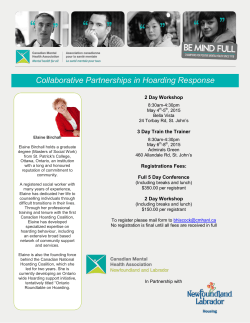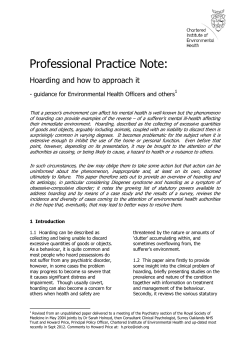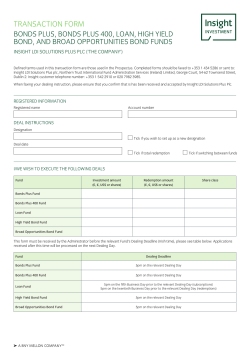
Document 145547
7/6/12 Features, Conceptualiza7on, and Treatment of Hoarding Disorder Overview • Diagnosis and Features of hoarding • Cogni7ve behavioral model of hoarding Gail Steketee, PhD and Randy Frost, PhD July 27, 2011 IOCDF Chicago, Ill DSM-‐V Criteria for Hoarding Disorder – Criterion A • Persistent difficulty discarding or par7ng with possessions, regardless of whether they are perceived by others to be valuable or not • Assessment of hoarding • Interven7on for hoarding DSM-‐V Criteria for Hoarding Disorder -‐ Criterion B • This difficulty is due to a perceived need to save the items and distress associated with discarding them 1 7/6/12 DSM-‐V Criteria for Hoarding Disorder – Criterion C • The symptoms result in the accumula7on of possessions that congest and cluTer the ac7ve living areas and substan7ally compromise their intended use. – If living areas are uncluTered, it is only because of the interven7ons of third par7es (e.g., family members, cleaners, authori7es) DSM-‐V Criteria for Hoarding Disorder -‐ Criterion E • The hoarding is not aTributable to another medical condi7on (e.g., brain injury, cerebrovascular disease, Prader Willi Syndrome). DSM-‐V Criteria for Hoarding Disorder -‐ Criterion D • The hoarding causes clinically significant distress or impairment in social, occupa7onal, or other important areas of func7oning (including maintaining a safe environment for self and others). DSM-‐V Criteria for Hoarding Disorder -‐ Criterion F • The hoarding is not beTer accounted for by the symptoms of another DSM-‐5 disorder (e.g., OCD, depression, demen7a). 2 7/6/12 Proposed Diagnos7c Specifiers • With Excessive Acquisi7on " If symptoms are accompanied by excessive collec7ng or buying or stealing of items that are not needed or for which there is no available space. • Poor insight Poor insight specifier • Good or fair insight: Recognizes that hoarding-‐related beliefs and behaviors (pertaining to difficulty discarding items, cluTer, or excessive acquisi7on) are problema7c. • Poor insight: • Absent insight: Poor insight specifier Poor insight specifier • Good or fair insight: • Poor insight: Mostly convinced that hoarding-‐ related beliefs and behaviors are not problema7c despite evidence to the contrary. • Absent insight: • Good or fair insight: • Poor insight: • Absent insight (Delusional beliefs about hoarding): Completely convinced that hoarding-‐related beliefs and behaviors are not problema7c despite evidence to the contrary. 3 7/6/12 Irene • • • • 53 year old woman 2 children Husband just moved out Hoarding began in childhood Manifesta7ons of Hoarding Acquisi5on Saving Disorganiza5on Compulsive Saving / Difficulty Discarding • Acquisi7on – Buying – Free Things – Stealing – Passive • Types of items – Clothes, newspapers, books, containers – DSM-‐IV – worthless & worn • ATachments – Sen7mental – Instrumental – Intrinsic 4 7/6/12 Disorganiza7on Epidemiology • Samuels et al. (2008) = 5.3% US (adjusted) • Condi7on of Home – CluTer – Mixed importance • Iervolini et al. (2010) = ~2% UK • Behavior – Churning • Mueller et al. (2009) = 4.6% Germany – Out of sight fear • Timpano et al. (2011) = 5.8% Germany Low frequency of OCD in hoarding Core beliefs & vulnerabilities Information processing Hoarding Sample (n=217) Attachments & Valuation of objects 18% OCD No OCD Nega7ve Reinforcement Emotions Neg. Pos. Posi7ve Reinforcement Saving & Acquiring Frost et al., 2011 5 7/6/12 Biological vulnerability Core Beliefs & Psychological Vulnerabili7es • Self-‐worth – I’m worthless. • Neural mechanisms • Mood • Co-‐morbidity • Helplessness – I have no control. Nothing I do will make a difference. • Gene7cs Informa7on Processing Deficits • ATen7on • Percep7on • Categoriza7on • Associa7on • Memory • Complex Thinking Emo7onal ATachments and Beliefs • • • • • • Beauty/aesthe7cs Memory U7lity/opportunity Sen7mental Comfort Safety • Iden7ty or poten7al iden7ty • Control • Mistakes • Responsibility/waste Decision-‐making Difficul7es 6 7/6/12 Learning Processes Avoidance condi7oning • Posi7ve reinforcement (posi7ve emo7ons) • Nega7ve reinforcement (nega7ve emo7ons) • No opportunity to test beliefs & appraisals (avoidance) • • • • • • Distress Decisions ATending to cluTer Feelings of loss Feelings of vulnerability Worries about memory • Invi7ng people into the home • Making mistakes • Losing opportuni7es • Losing informa7on • Depression • Punng things out of sight • No opportunity to develop alterna7ve beliefs (avoidance) Core beliefs & vulnerabilities Information processing Func7onal Analysis of Compulsive Shopping Episode Attachments & Valuation of objects 40 year old professional woman Nega7ve Reinforcement Emotions Neg. Pos. Saving & Acquiring Husband & 12 year old son Posi7ve Reinforcement $27,000 credit card debt Clothes buying compulsion Serious hoarding problem 7 7/6/12 Hoarding Interview Compulsive Buying Episode Hoarding Ra7ng Scale hTp:// www.ocfounda7on.org/hoarding/tests.aspx • 1. 2. 3. 4. 5. 0-‐8 scales for 5 items: Difficulty using rooms in your home? Difficulty discarding Problem collec7ng or buying Emo7onal distress Impairment • • • • • • • Home and cluTer Objects and reac7ons Where to start Organiza7onal system Acquiring Reasons for saving Family & friends • Health & safety • Problems from hoarding • Comorbidity (MDD, OCD, ADHD, etc.) • Family history of hoarding • Onset & course • Interven7on efforts Saving Inventory-‐Revised Cutoff scores • Excessive Acquisi7on • Difficulty Discarding • CluTer • Total Score 9 14 17 41 8 7/6/12 Ac7vi7es of Daily Living • Item examples: • Subscales: – Kitchen – Bathroom – Common Areas Mo7va7on • What makes people mo7vated to change? – Importance – Confidence • Mo7va7onal Interviewing – A client-‐centered, direc7ve method for enhancing intrinsic mo7va7on to change by exploring and resolving ambivalence • Anosognosia (nosos + gnosis) – Lack of awareness or denial of a disability or deficit – Indifference to consequences • CluTer Blindness • Overvalued Ideas Frost et al. (2010) – Eat at table – Prepare food – Use refrigerator Insight Problems • Defensiveness Ambivalence • Even people with poor insight are ambivalent – They know others’ view of the way they live. – They feel shame when others see their home. • We must begin here if we hope to get them to change. 9 7/6/12 Style of MI Principles of MI • Collabora7on, not confronta7on • Expressing empathy • Evoca7on, not educa7on • Developing discrepancy • Autonomy, not authority • Rolling with resistance • Suppor7ng self-‐efficacy Strategies for Enhancing Mo7va7on Ask open-‐ended ques7ons Listen with reflec7on Summarize Affirm self-‐efficacy Ask evoca7ve ques7ons Explore pros & cons Ask for elabora7on Use extreme contrasts Look forward Look back Reframe Provide feedback Encourage change talk Components of Treatment of Hoarding • • • • • • Assessment and case formula7on Mo7va7onal enhancement Skills training – organizing, problem solving Trea7ng excessive acquisi7on Changing ATachments to Things Preven7ng relapse Steketee & Frost, 2007 10 7/6/12 Treatment Format 6 mos -‐1 yr of treatment, some7mes more in severe cases Individual or group Office and in-‐home sessions (webcam?) Prac7ce in acquiring loca7ons Family consulta7on Case Formula7on • Develop model for understanding client’s problems • Draw connec7ons of (1) thoughts & beliefs to (2) emo7ons and to (3) behaviors, both ac7ve acquiring & saving and passive avoidance of discarding • Help client understand why hoarding habits are hard to break because of posi7ve and nega7ve reinforcement Assistance from a coach Cleanout with trained staff or coach for extensive cluTer Senng Personal Goals and Values Ask about personal values What does the client care most about Family, friends, honesty, achievements, etc. Iden7fy and list personal goals What does the client most want to do in the remainder of his/her life? Refer back to personal goals and values throughout treatment to clarify ambivalence and increase mo7va7on Example: Sharon’s Goals To enjoy my instruments again To create breathing space, order, and beauty in my bedroom (esp. in front of the closet) To have a living room that a friend or family could enter To have a safe kitchen with working surfaces To take a bath To remove bagged items 11 7/6/12 Skills and Plan for Organizing Categorize and organize wanted items Iden7fy categories for types of items Select loca7ons for item categories Discuss storage loca7ons and furnishings Select interim loca7ons during sor7ng Skills for Problem Solving and Decision-‐ Making Problem-‐solving skills Define the problem, brainstorm solu7ons, select one, try it, assess outcome, revise as needed Prac7ce decision-‐making, iden7fy useful rules for acquiring, discarding, keeping, etc. Categorize unwanted items Trash, recycle, donate, sell; few undecided Develop ac7on plan for removing items Rules for Decision Making Skills to Manage ATen7on Do I need it? Do I have a plan to use this? Have I used this in the last year? Can I get it elsewhere? Do I have enough space to keep this? Will genng rid of this help my hoarding problem? Determine usual aTen7on span Help client reduce and/or delay distrac7bility Use 7mer Control visual field (cover distrac7ng areas) Discuss ways to create structure Regular appointments for sor7ng Establish priori7es Divide projects into manageable steps 12 7/6/12 Cogni7ve Therapy During non-‐acquiring and discarding prac7ce Iden7fy thinking errors Iden7fy problema7c beliefs Evaluate/challenge beliefs Socra7c ques7oning Downward arrow for worst fears and core beliefs Pros and cons, value of 7me vs stuff Taking another perspec7ve Behavioral experiments Treatment for Compulsive Acquiring Iden7fying paTerns of acquiring Create a hierarchy Cogni7ve restructuring of beliefs about acquiring Non-‐acquisi7on exposures Drive-‐by non-‐shopping Walk-‐through non-‐shopping Browsing and picking non-‐shopping Coping with empty space Gradual Exposure Prac7ce and Homework Collect box or bag of items from home to bring to office Work from easier to harder items Gradually reduce therapist assistance in making decisions Sort similar items at home between sessions star7ng in easier loca7ons with highest mo7va7on As person gains skills, bring only difficult items to sort Make sure sorted items are moved to storage loca7ons or out of home Ques7ons to Challenge Acquiring • Do I have an immediate use for this? Can I get by without it? • Do I want it taking up space in my home? • Is this truly important or do I want it just because I was looking at it? • What are the advantages and disadvantages of acquiring this? • Personal rules for acquiring– I must have: – An immediate use for it – Time to deal with it appropriately – Money to afford it comfortably – Space to put it 13 7/6/12 Roles for Coaches and Family • Help the client stay focused on sor7ng/ discarding tasks • Provide emo7onal support • Help with decisions, but don’t make them for the client • Be a cheerleader • Help with hauling • Accompany the person on non-‐acquiring trips • Help them cope with change Downward Arrow Technique • What would happen if you threw that out? • Why would that be so bad? • What would be so bad about that? • And what would that mean about you? • So, if you threw this out, then … Coping with Change Coping with loss Evaluate true versus imagined loss Coping with empty space Developing new uses for spaces Decorate space Changing habits Coping with extra 7me Plan non-‐acquiring ac7vi7es Expand social ac7vi7es Downward Arrow Technique • What would happen if you threw that out? – “I’ll never find it again.” • Why would that be so bad? – “I would lose an opportunity.” • What would be so bad about that? – “I’d be stupid for not taking advantage of an opportunity.” • What’s the worst part about that? – “Just that, I’d be a stupid person.” 14 7/6/12 Downward Arrow 2 • It sounds like you are worried that if you threw this out, that would mean you were a stupid person. Let’s take a look at that idea. – “I guess I never thought about it. I do worry about doing something stupid.” • Sounds like you also worry that you might be a stupid person. Does that seem right? Behavioral Experiment Example (top of lost game board box) • Predic7on 1: “If I throw this away, it will feel like death.” • Predic7on 2: “If I throw it away, I will feel this way (like death) forever.” – “Yeah, I guess so. All through school….” Outcome of Predic7ons • One minute ayer discarding – Distress ra7ng at 100, but “It does not feel like death.” • 24-‐hours ayer discarding – Distress ra7ng at 10. “It doesn’t bother me much at all.” Conclusions and New Hypotheses • Conclusion -‐ Neither predic7on came true. • New Hypotheses – The thought of throwing things away is worse than the doing of it. – If I throw something away that I am deathly afraid of discarding, it will not feel as bad as I think, and the bad feeling won’t last as long as I think. 15 7/6/12 Socra7c Ques7oning: Thinking it Through Logically • How likely is the feared outcome? • What evidence is there to support the belief? Taking Another Perspec7ve • Designed to help clients step outside their own view of the world • How catastrophic would this be? – Would your friend (family member) view this situa7on in the same way? – What would you say to a friend who came to you with this problem? – What would you say to your son or daughter if they came to you with this problem. • How well could you cope with not having this? • How much distress would you feel? • How long would the distress last? • Can you tolerate the feeling? • Is your thinking coming from some7me or someone in your past? Controlled Trial: Saving Inventory-‐Revised (n=46) Advantages/Disadvantages • Advantages of Not Acquiring • Disadvantages of Acquiring – I can’t afford this right now. – I don’t have room for this. – I already have too many like it. % Reduction – I’ll have more money for other things. – I want to be able to choose without feeling compelled. – It will help me solve my hoarding problem. 0% 12 -5% 26 -10% -15% -20% -25% CBT Wait list Partial ETA2 = .223 -30% Partial ETA2 = .475 29% reduction -35% Session 16 7/6/12 Controlled Trial Responders (much or very much improved) Treatment Responders (%) 90 80 70 60 50 Post 40 Followup 30 20 10 0 Self-‐ra7ng Therapist Steketee et al., 2010; Muroff et al., 2011 Specialized CBT beats the Compe77on 80% 70% 60% 50% 40% 30% 20% 10% 0% individual CBT-‐26 wk T T C C B B ed ix 10 .( 20 20 .( al al et et 0 2 4 6 8 10 12 14 16 18 St ek et ee in To l biblio-‐therapy-‐20 wk ), ), 07 ), 06 20 .( al et er uf R ow itz am M ), 03 .( 20 al et al et xe na A br Sa ER P R SS ), 06 .( .( al et s C ol xai at M 20 20 98 .( 19 al et ck la I P R 02 M ), ), 99 19 .( al et g ), E ix SS R ed I group CBT-‐20 wk B er sb W in Average SI-‐R Changes Before & Ayer Therapy by CBT method 17 7/6/12 Conclusions Compulsive hoarding is common, chronic, and debilita7ng to the individual and family Hoarding is associated with unique biological, cogni7ve, and behavioral features Specialized CBT reduces hoarding symptoms and improves upon previous treatments Need to refine treatments to increase its impact (e.g., homework completed) and reduce therapy 7me 18
© Copyright 2025
















